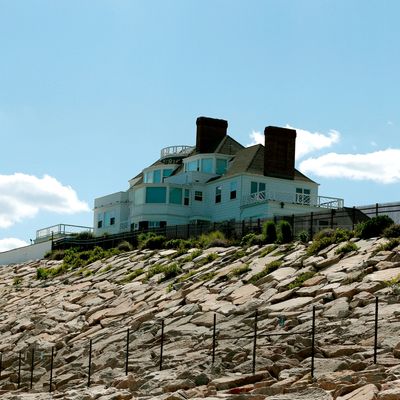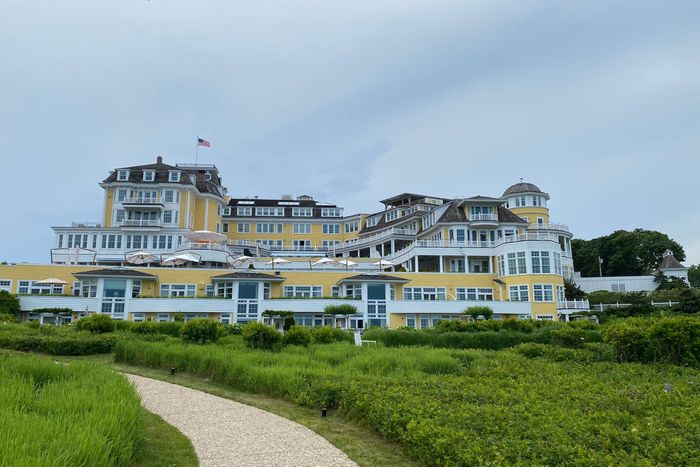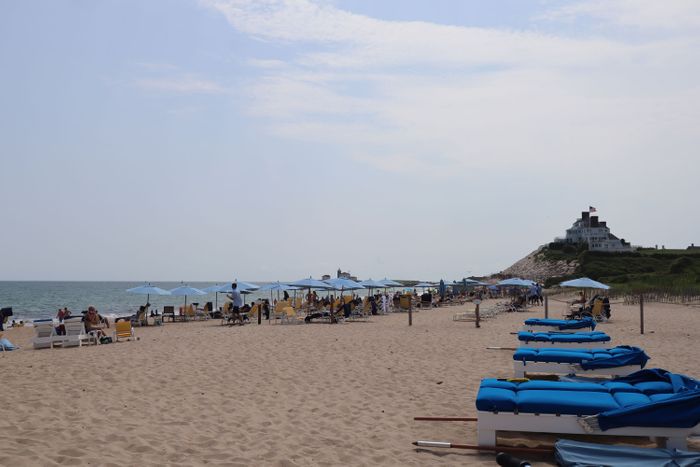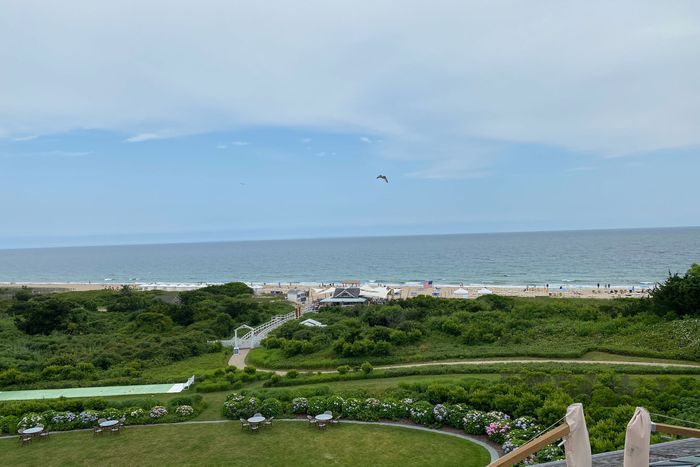
Unlike the more accessible Watch Hill Beach across the way, East Beach isn’t easy to find. Unless you’re especially gifted at finding out-of-the-way stretches of sand, you’ll probably need someone who’s been there before to show you where it is. Your first obstacle is finding a parking space. The tiny hamlet of Watch Hill, Rhode Island, has one circular road as its main artery, with only a handful of nonresident spaces and little lots that sell out first thing in the morning, even at $40 or more a space.
Then, you take your beach chair and your bag and anything else you’ll need, because that beach has no facilities whatsoever, not even a trash can, and you trudge up the hill to what is believed to be the highest point on the ocean on the Eastern Seaboard. Head for the tall, thorny bushes and look for the narrow path through them. (You might get lucky and get a town-sponsored hint: Sometimes there’s a traffic cop at the start of the path to make sure nobody gets dropped off there and stops traffic at the precarious bend in the road.) Then walk down the slope, which gets craggier and craggier as you go. Stop when you hit the sand. Take off your shoes. You’ve found the best beach in New England.
I loved Taylor Swift’s beach long before I loved Taylor Swift. Maybe the same things appealed to her about East Beach as appealed to me: the pristine sand, the view of Long Island across the sound, the remoteness, the feeling that, by finding it, you had really earned your place there in a way the people on the other side of the peninsula hadn’t. They can keep their seaweed and their seagulls and their kids splashing in the mellower surf. The other side is a tiny, perfect piece of hard-won paradise.
Ironically, the public part of that beach is harder to find than the private parts. To the left, it belongs to Ocean House, a spectacular (and spectacularly expensive) hotel originally built 150 years ago, where celebrities like Oprah Winfrey, Jessica Simpson, and the late, great Regis Philbin were seen. To gain access, all you have to do is pony up $1,500 a night.
To the right, it belongs to Taylor Swift.
From the shore and from the street, Taylor Swift’s mansion — the one she sings about in “the last great american dynasty” on her new album folklore — is unmissable. It’s the high point in Watch Hill, both geographically and in price. The $17.75 million High Watch (once called Holiday House) is the most expensive private home in Rhode Island. It has a driveway that meets the street, just like any normal person’s house, and a little gate that doesn’t seem all that secure until you spot the security guards roaming the grounds. For a while when she first moved in, in 2013, Swift had a sign out front: “I knew you were trouble when you walked in. NO TRESPASSING.” If you didn’t already know a pop star lived there, you did when you saw that sign.
Maybe her transparency is what people didn’t like. Swift put herself out there, right in plain view, just like she does in folklore and the seven albums before that. (So far out there that fans have scaled the seawall and fence to get onto her property, tried to break in, and even tried to swim there.) The old-money families in Watch Hill have passed those homes down through generations. Even Conan O’Brien, who lives just around the corner, gets a pass from whispered scrutiny, maybe because he bought the house from his parents in 1997. He’s fussed over so little that even someone like me, who lives close enough to go to Watch Hill at least twice a month year-round, didn’t know he lived there until recently.
The thing about Watch Hill is that it’s where wealthy people who don’t want the commotion of the Hamptons or Nantucket go to keep themselves tastefully tucked away. But you can’t “tuck away” one of pop music’s biggest forces: a woman so talented and popular that she not only earned enough to plunk down a cool $17.75 million to buy the property, but she did it in cash.
Rebekah Harkness didn’t tuck herself away either. The woman who owned Holiday House for more than 30 years, from the 1950s until her death in 1982, was famous for her glamorous parties that brought in the likes of Salvador Dalí. “the last great american dynasty” recounts Harkness’s legacy, in Swift’s words, and the oil heiress’s antics have been widely reported since then.
But even if you don’t know the history of the home and the “maddest woman this town has ever seen,” it’s easy to identify the common theme between Harkness and Swift. Two women who have their own money, who are criticized at every turn for how they choose to spend it. In her song, Swift writes that Harkness was blamed for her husband’s early death, and judged for ending one of America’s richest families. (Bill Harkness was the heir to the Standard Oil fortune.) And then, she brings it back to herself. “Who knows, if I never showed up, what could’ve been / There goes the loudest woman this town has ever seen / I had a marvelous time ruining everything.”
Taylor Swift and the State of Rhode Island have their own contentious history. First, as soon as she bought the house in 2013, came grumblings from locals about traffic created by the flood of fans who just wanted to see the house. Then they got angry that she dared to stake her claim on the part of the beach she rightly owned, even though people had been using it for years. Next came the controversy over Swift wanting to rebuild a seawall on her own property. People claimed her construction — which was to repair damage done by erosion — would impede public access and would ruin the popular surfing spot. Then came the Taylor Swift tax.
In 2015, Rhode Island governor Gina Raimondo proposed a tax on second homes in the state worth over $1 million, which quickly became known as the “Taylor Swift tax,” inspired by that Watch Hill purchase. The proposal was widely viewed as a detractor for future tourism in the state, especially since people with second homes spend money without straining infrastructural resources like school systems. Raimondo defended the proposal as potentially adding $12 million to the state’s economy, but then withdrew it. (The governor has since recovered from that criticism; Raimondo’s handling of the pandemic has put Rhode Island among the states with the lowest infection rates, and has given her the highest approval rating for a Democratic governor in the country.)
Try to imagine a chillier welcome than an entire state attempting to create new tax legislation that was not just aimed at taking your money but was also named after you.
Swift has said that her biggest mistake in creating her public image was not being forthcoming enough about how carefully crafted it was. Some of the most careful crafting has happened at High Watch. She held secret first-listen sessions there for reputation. She brought in hordes of celebrities for her famous — and perfectly Instagrammed — Fourth of July parties. She did exactly the kind of things that a modern-day Rebekah Harkness would have done. Harkness may have filled her pool with Champagne and not flamingo and unicorn pool floats, but she brought in the celebrities of her day, and she installed a dome on her lawn as a rehearsal space for her ballet company. It made the neighbors furious. In my head, that dome looks exactly like the enormous 27-foot-tall waterslide Swift had at her 2016 extravaganza. The parallels between the two of them are strong enough that it’s hard not to hear the lyric, “Rebekah gave up on the Rhode Island set forever,” as Swift’s own feelings toward my home state.
There have been sightings of Taylor Swift all over Westerly, the town Watch Hill is a part of. She’s been seen having breakfast at the Cooked Goose, doing her grocery shopping at McQuade’s Marketplace, having dinner at Olympia Tea Room. She and Lorde took a private cooking class at Ella’s Fine Food & Drink. Her parents are around so much that they’ve practically become locals. Once, after she tweeted about being at Ella’s, two young girls came in looking for the table where Taylor Swift had sat. Her dad, Scott, happened to be at the restaurant that night. “Her father walked right over and gave them photos and guitar picks,” remembers chef Jeanie Roland, co-owner of Ella’s, who had given her that cooking lesson. “He took photos with them. They love the fans.”
But Swift hasn’t been spotted around much lately. Her last Fourth of July party there was in 2016, the year of the Kimye feud and Swift’s ensuing cancellation. I was on East Beach the day of the party; there were paparazzi camped out all over. (I saw a man and a woman playing football on the lawn of her house, but all I know for sure was that the man was definitely not Ryan Reynolds.) That summer was also the last time she was photographed publicly in the state.
It says something that she’s been scrutinized this much in a town where, until a public outcry and a rash of bad press in 2016 prompted a change in policy, the Westerly Yacht Club did not allow women to be full-time members. It says something more that when Jay Leno bought a $13.5 million mansion in Newport, Rhode Island, in 2017, nobody said a negative word about it; there was certainly no proposed Jay Leno Tax.
But then again, just last year, Swift told Ellen DeGeneres that her favorite place to go on holiday was still Rhode Island. DeGeneres kind of shrugged. “It’s a great state,” Swift replied. So maybe she’s just gotten better at keeping a low profile.
“I know that she loves her home,” chef Roland tells me. “I’ll cook for her kids one day. That’s what I think.”




